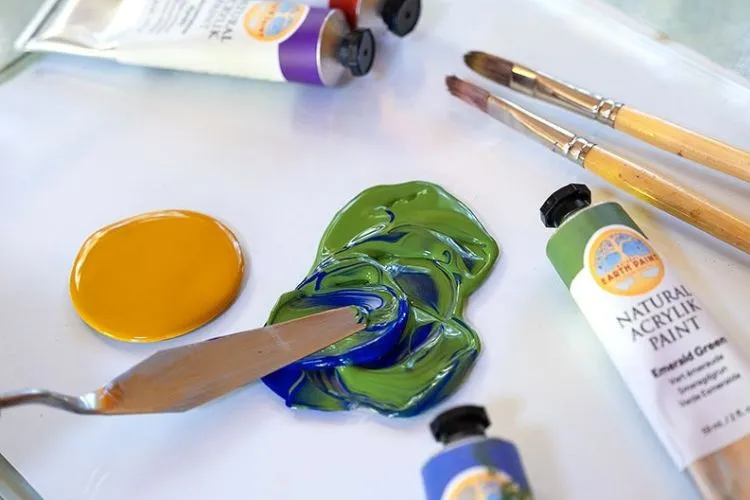In the vibrant world of arts and crafts, acrylic paint holds a special place thanks to its versatility and ease of use. Artists, from beginners to professionals, often reach for acrylics to express their creativity.
However, the question of its safety and potential toxicity arises, casting a shadow on its colorful application. So, is acrylic paint toxic?
This article explores the composition of acrylic paint, its health implications, and safe usage practices to ensure that art remains a joyful and safe endeavor for everyone involved.

What Is Acrylic Paint?
Acrylic paint is a water-based medium known for its quick drying time and adaptability to various surfaces.
Its invention in the 1940s revolutionized the art world, providing artists with a synthetic alternative to oil and watercolor paints.
Commonly used in art projects, decorations, and even home improvements, its popularity is undisputed. But what exactly goes into these vibrant tubes of color?
Composition of Acrylic Paint
At its core, acrylic paint consists of pigment for color, a binder of acrylic polymer emulsion to hold the pigment together, and water to give it a manageable consistency.
Additionally, manufacturers may add various chemicals to alter its thickness, drying time, and finish.
While this composition enables artists to achieve their desired visual effects, it’s these additives that bring about health concerns.
Is Acrylic Paint Toxic?
The potential for acrylic paint to pose health risks primarily comes from its chemical components, the presence of Volatile Organic Compounds (VOCs), and heavy metals in the pigments.
- Chemical Components: Some acrylic paints contain harmful chemicals that can impact health. These may result in irritation to the skin, eyes, throat, and lungs upon prolonged exposure. Understanding the risks associated with these chemicals is crucial for artists who spend hours engrossed in their work.
- Volatile Organic Compounds (VOCs): VOCs are substances that can easily become vapors or gases. In the context of acrylic paints, VOCs can be released as the paint dries, potentially causing headaches, dizziness, and, in severe cases, damage to the liver, kidney, and nervous system.
- Heavy Metals in Pigments: Certain pigments used to color acrylic paints may contain heavy metals like cadmium, chromium, and lead. These substances are known for their toxicity and can pose severe health risks if ingested or inhaled over time. Regulations and safety standards are in place to limit the use of heavy metals, but awareness and caution are still advised when handling pigments.
Safety Labels and Certifications

Understanding labels such as “non-toxic” and seeing the AP (Approved Product) mark from the Art & Creative Materials Institute (ACMI) can help users make informed choices.
These certifications indicate that the product has been tested and deemed safe for use under specified conditions.
Reading product labels and Material Safety Data Sheets (MSDS) provides insight into the composition and potential hazards of the paints.
You may also find useful: Is Acrylic Paint Flammable or Combustible?
Proper Usage and Handling of Acrylic Paint
Adopting safe painting practices can greatly reduce the risks associated with acrylic paints. Ensuring good ventilation, wearing protective gloves, and avoiding skin contact are basic steps everyone should take.
Additionally, knowing how to dispose of unused paint and cleaning materials properly protects both the artist and the environment from potential harm.
Acrylic Paint Safety for Specific Groups
When using acrylic paints, it’s essential to consider the safety of vulnerable groups such as children, pregnant women, and individuals with respiratory issues.
For these groups, even low levels of toxins could pose significant health risks. Children, for example, are more prone to ingest paints or get them on their skin due to their explorative nature.
Pregnant women should avoid exposure to certain chemicals that could potentially harm the developing fetus. Similarly, those with respiratory conditions might be more susceptible to the fumes emitted by some acrylic paints.
To safeguard these groups, opt for acrylic paints explicitly labeled as non-toxic. These products adhere to stricter safety standards and contain fewer harmful chemicals.
Additionally, consider natural paint alternatives that use organic pigments and binders.
Always ensure good ventilation in the workspace, and consider using protective equipment such as gloves and masks to minimize direct contact and inhalation of paint particles. Such precautions help maintain creativity while ensuring the safety of all users.

Alternatives to Traditional Acrylic Paints
For those concerned about the potential health risks of traditional acrylic paints, there are alternatives. Natural paints, made from organic materials and void of synthetic chemicals, offer a safer option.
While they may not always match the durability and color range of their acrylic counterparts, they offer peace of mind for health-conscious individuals.
Frequently Asked Questions (FAQs)
Is it safe to use acrylic paint indoors?
Yes, it is generally safe to use acrylic paints indoors, especially if they are labeled non-toxic. However, ensuring good ventilation can minimize the risk of inhaling any harmful fumes.
What should I do if I accidentally ingest acrylic paint?
Ingesting a small amount might not cause harm, but it’s best to consult with a doctor or poison control center immediately for advice based on the specific paint ingested.
How can I minimize exposure to toxic substances when using acrylic paint?
Work in a well-ventilated space, use personal protective equipment like gloves and masks, and choose non-toxic paints whenever possible to reduce exposure.
Are there any acrylic paints available that are free from heavy metals?
Yes, there are acrylic paints formulated without heavy metals. Look for those specifically marked as non-toxic and check the ingredient list or MSDS for confirmation.
How do “non-toxic” acrylic paints differ from regular acrylic paints?
Non-toxic acrylic paints are formulated without hazardous chemicals or heavy metals, making them safer for general use, especially by children or in environments where safer materials are preferred.
Conclusion:
Acrylic paint, a staple in the world of art, comes with its set of safety considerations. Being mindful of its composition and the potential for toxicity can ensure that creativity flows without compromising health.
By choosing the right products, employing safe handling practices, and considering less toxic alternatives, artists can continue to bring color to the canvas while safeguarding their well-being.
Choosing acrylic paints with awareness and care ensures that artistic endeavors remain both joyful and safe.
With a variety of products on the market and a growing concern for health and safety standards, painters have many options to keep their art on canvas and the toxins out of their system.

Meet Isabella Anderson, your acrylic painting mentor with over a decade of brush-wielding mastery. Dive into the colorful world of acrylics with her expert guidance, featured exclusively on ‘Acrylic Authority.’ Unleash your inner artist and explore the limitless possibilities of this versatile medium alongside a true acrylic aficionado.
